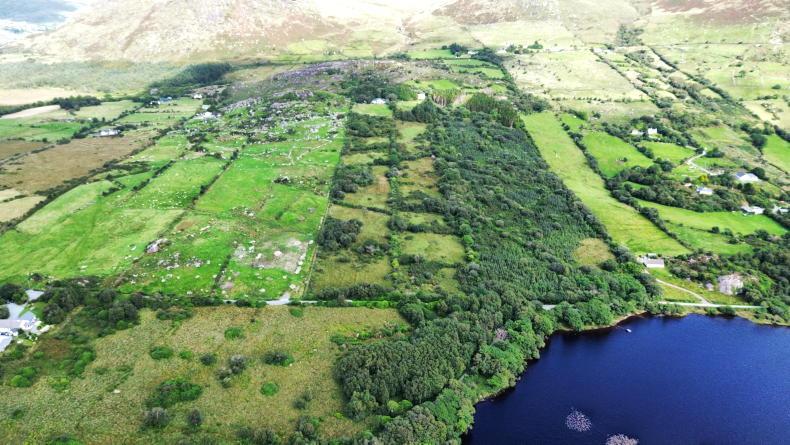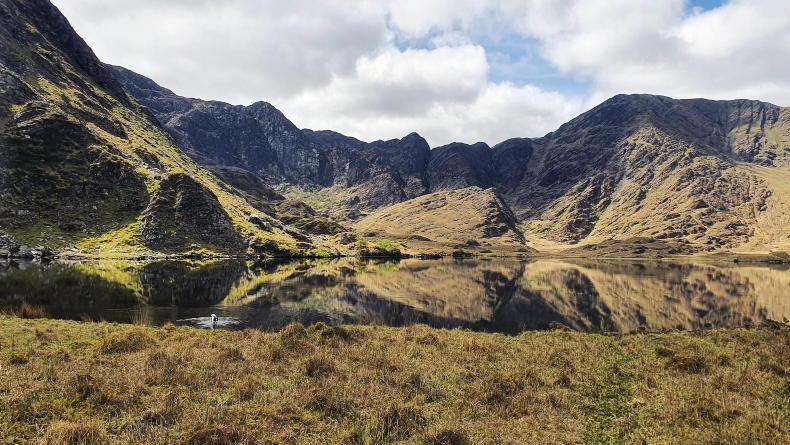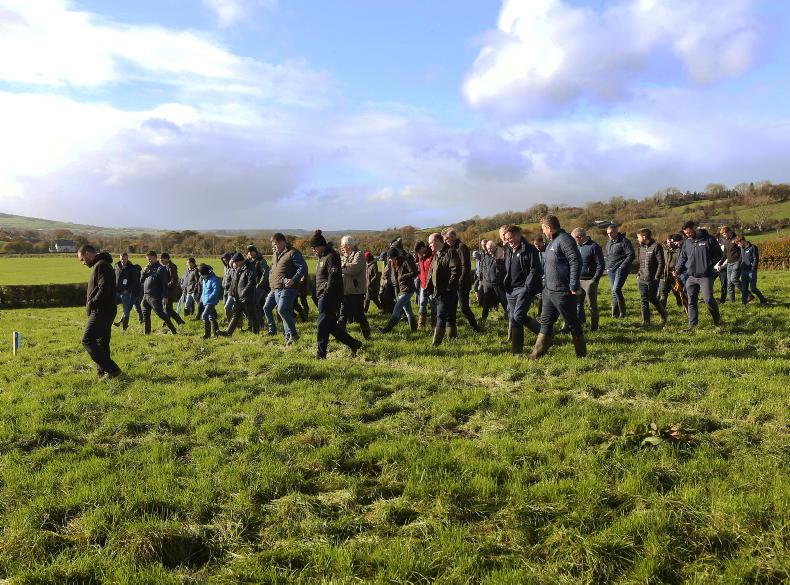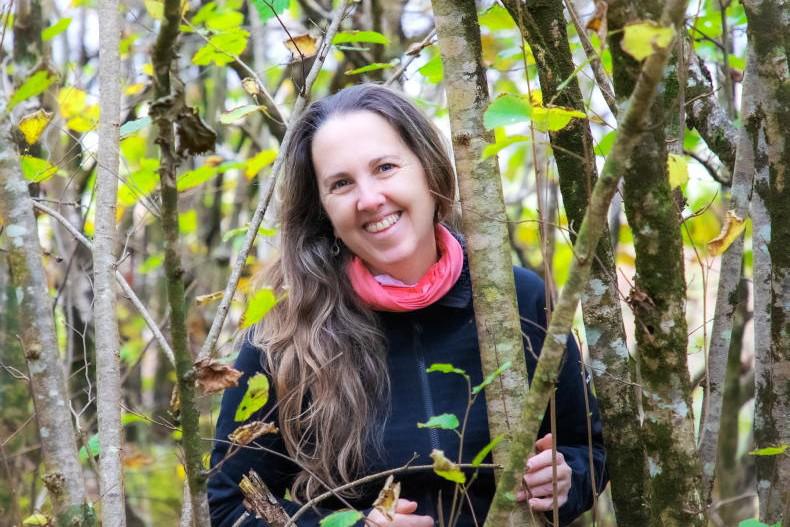Ireland’s uplands have a unique aesthetic, one unfamiliar to visitors from Europe and North America.
While trees grow thousands of metres up into the Alps or the Appalachians, our mountains stand bare.
This landscape is so familiar to us now that many, even those who know the land, would contend that trees simply won’t grow there - ‘it’s too exposed’, ‘the soil is too poor’.
Contrary to this assumption, historical evidence - embedded in old maps, place names and palaeoecological studies - reveals a past draped in forests of sessile oak, Scots pine, birch, aspen and juniper across Ireland’s mountains.
Echoes of these ancient forests can still be heard today in townland names. ‘Cliff of the birch’ (Faill an Bheithe) or ‘Milking place of the willows’ (Macha na Saileach) are two such names from south Kerry, drawn from a list of over 70 compiled by Dr Eugene Costelloe for his paper 'Hill farmers, habitats and time'.
Remnants of lost upland forests
The physical remnants of our lost upland forests can still be observed. Some recent surveying work we had done at Hometree noted the presence of Scots pine stumps around 400m up in the Maamturks.
For the intrepid, living examples may still be found in tiny isolated pockets that cling on in deep ravines high in the
Sperrins or the Reeks.
Experts agree that Ireland’s mountains lack the height threshold for a true treeline - an altitude above which trees can’t survive.

At a recent uplands symposium organised by Teagasc, there was not a single speaker nor mention of trees.
While they may grow stunted or crooked, they will undoubtedly grow. The reason they are not there today is that they were cleared by our ancestors and the reason they have not come back is year-round grazing pressure from domestic livestock and deer.
Despite the definitive evidence of our uplands forested past, farmers living in these areas who wish to recreate them today will find it nearly impossible to get state support or even permission to do so.
Policy obstacles
The dominant obstacles are land use restrictions associated with European habitat designations and afforestation rules set down by the forest services.
Landowners living within a special area of conservation on which woodland is not listed as a qualifying interest will struggle to get support. Similarly, if land is in a special protection area or natural heritage area, farmers face an uphill battle.
I was recently out on Clare Island and a farmer was telling me that whole island is now a proposed natural heritage area.
This designation accrues zero benefits to landowners, but is nonetheless prohibiting this individual from getting support for a small-scale native woodland.
For upland farmers living outside protected areas, the forest services own rules make afforestation equally difficult. Many of these rules are based on outdated views on a potential site’s “production capacity” - this ignores the broad range of non-timber public goods trees can provide.

While we have successfully brought commercial forestry down from the mountains, we seem to have forgotten there remains a place for native woodlands.
The official altitude limit for broadleaf trees in the west is just 120m. Sites with over 25% bare rock or sites proximate to the sea are also ruled out. Such conditions result in vast areas of land, where trees would happily grow, being disqualified from schemes.
Recently introduced criteria relating to high nature value lands, breeding waders and shallow peats further narrow the scope for upland afforestation.
It goes without saying that new protections afforded to rare habitats and endangered species are a good thing. Viewed alone, each one can be resolutely defended, but applied collectively, they function as an effective ban on upland woodland creation.
Regulation of afforestation seems to have swung pendulum-like from the destructive free-for-all of the 1980s and 1990s to a scenario where, apart from very prescribed circumstances, it is hard to get support to create upland woodlands, even in places they rightly belong.
Wild trees
Despite the obstacles outlined above, recent changes to land eligibility rules may see wild trees return to the uplands at scale, but not necessarily in a way that will benefit farmers.
Prior to these changes, payment penalties were applied to farmers who didn’t clear scrub or early-stage woodland. These penalties are now essentially gone.
I believe most people haven’t grasped the significance of this rule change. Even before it was introduced, large areas of land were falling into a wild state.
Demographics and profitability
In fact, half of all woodlands created in the State between 2017 and 2022 arose through natural regeneration. With the ageing demographic and marginal profitability of uplands farms, a major withdrawal from parts of the landscape could easily occur.
While this change may ultimately benefit native woodland restoration, the unstructured nature of it presents ecological challenges such as invasive species proliferation or habitat displacement. It also raises questions of fairness.
There is an inherent inequity in paying lower payments for naturally regenerated wild woodlands in the uplands (~€200/ha/year) compared with planted ones in the lowlands (up to €2,240/ha/year).
Both woodland types can contribute to Ireland’s strategic land use ambitions, be it flood mitigation or carbon sequestration, and should be remunerated in a way that is proportionate to that contribution.
The challenge of preserving existing upland habitats, and farmers’ incomes while tapping into the latent potential of restoring indigenous woodlands is an unenviable one.
Aligning the relevant policy frameworks is a delicate balancing act, but one we must get right.
Ray ó Foghlú is an environmental scientist and woodland conservationist. He is the farm programmes co-ordinator with the Hometree charity.
Ireland’s uplands have a unique aesthetic, one unfamiliar to visitors from Europe and North America.
While trees grow thousands of metres up into the Alps or the Appalachians, our mountains stand bare.
This landscape is so familiar to us now that many, even those who know the land, would contend that trees simply won’t grow there - ‘it’s too exposed’, ‘the soil is too poor’.
Contrary to this assumption, historical evidence - embedded in old maps, place names and palaeoecological studies - reveals a past draped in forests of sessile oak, Scots pine, birch, aspen and juniper across Ireland’s mountains.
Echoes of these ancient forests can still be heard today in townland names. ‘Cliff of the birch’ (Faill an Bheithe) or ‘Milking place of the willows’ (Macha na Saileach) are two such names from south Kerry, drawn from a list of over 70 compiled by Dr Eugene Costelloe for his paper 'Hill farmers, habitats and time'.
Remnants of lost upland forests
The physical remnants of our lost upland forests can still be observed. Some recent surveying work we had done at Hometree noted the presence of Scots pine stumps around 400m up in the Maamturks.
For the intrepid, living examples may still be found in tiny isolated pockets that cling on in deep ravines high in the
Sperrins or the Reeks.
Experts agree that Ireland’s mountains lack the height threshold for a true treeline - an altitude above which trees can’t survive.

At a recent uplands symposium organised by Teagasc, there was not a single speaker nor mention of trees.
While they may grow stunted or crooked, they will undoubtedly grow. The reason they are not there today is that they were cleared by our ancestors and the reason they have not come back is year-round grazing pressure from domestic livestock and deer.
Despite the definitive evidence of our uplands forested past, farmers living in these areas who wish to recreate them today will find it nearly impossible to get state support or even permission to do so.
Policy obstacles
The dominant obstacles are land use restrictions associated with European habitat designations and afforestation rules set down by the forest services.
Landowners living within a special area of conservation on which woodland is not listed as a qualifying interest will struggle to get support. Similarly, if land is in a special protection area or natural heritage area, farmers face an uphill battle.
I was recently out on Clare Island and a farmer was telling me that whole island is now a proposed natural heritage area.
This designation accrues zero benefits to landowners, but is nonetheless prohibiting this individual from getting support for a small-scale native woodland.
For upland farmers living outside protected areas, the forest services own rules make afforestation equally difficult. Many of these rules are based on outdated views on a potential site’s “production capacity” - this ignores the broad range of non-timber public goods trees can provide.

While we have successfully brought commercial forestry down from the mountains, we seem to have forgotten there remains a place for native woodlands.
The official altitude limit for broadleaf trees in the west is just 120m. Sites with over 25% bare rock or sites proximate to the sea are also ruled out. Such conditions result in vast areas of land, where trees would happily grow, being disqualified from schemes.
Recently introduced criteria relating to high nature value lands, breeding waders and shallow peats further narrow the scope for upland afforestation.
It goes without saying that new protections afforded to rare habitats and endangered species are a good thing. Viewed alone, each one can be resolutely defended, but applied collectively, they function as an effective ban on upland woodland creation.
Regulation of afforestation seems to have swung pendulum-like from the destructive free-for-all of the 1980s and 1990s to a scenario where, apart from very prescribed circumstances, it is hard to get support to create upland woodlands, even in places they rightly belong.
Wild trees
Despite the obstacles outlined above, recent changes to land eligibility rules may see wild trees return to the uplands at scale, but not necessarily in a way that will benefit farmers.
Prior to these changes, payment penalties were applied to farmers who didn’t clear scrub or early-stage woodland. These penalties are now essentially gone.
I believe most people haven’t grasped the significance of this rule change. Even before it was introduced, large areas of land were falling into a wild state.
Demographics and profitability
In fact, half of all woodlands created in the State between 2017 and 2022 arose through natural regeneration. With the ageing demographic and marginal profitability of uplands farms, a major withdrawal from parts of the landscape could easily occur.
While this change may ultimately benefit native woodland restoration, the unstructured nature of it presents ecological challenges such as invasive species proliferation or habitat displacement. It also raises questions of fairness.
There is an inherent inequity in paying lower payments for naturally regenerated wild woodlands in the uplands (~€200/ha/year) compared with planted ones in the lowlands (up to €2,240/ha/year).
Both woodland types can contribute to Ireland’s strategic land use ambitions, be it flood mitigation or carbon sequestration, and should be remunerated in a way that is proportionate to that contribution.
The challenge of preserving existing upland habitats, and farmers’ incomes while tapping into the latent potential of restoring indigenous woodlands is an unenviable one.
Aligning the relevant policy frameworks is a delicate balancing act, but one we must get right.
Ray ó Foghlú is an environmental scientist and woodland conservationist. He is the farm programmes co-ordinator with the Hometree charity.











SHARING OPTIONS